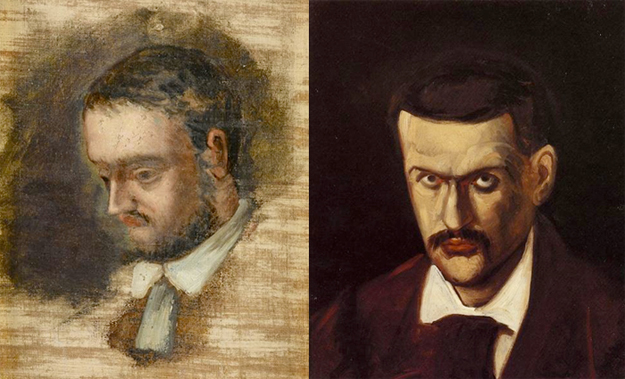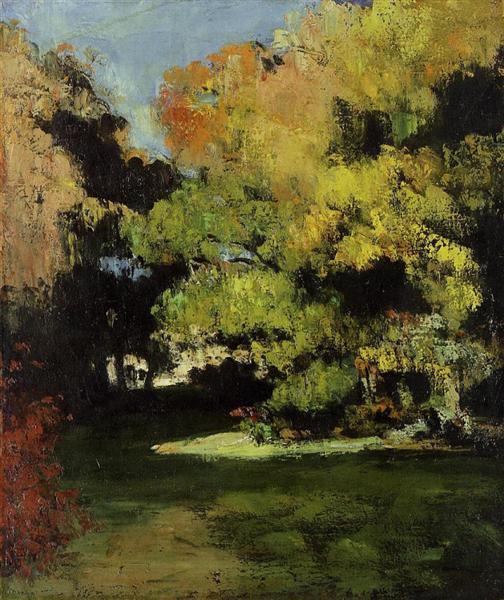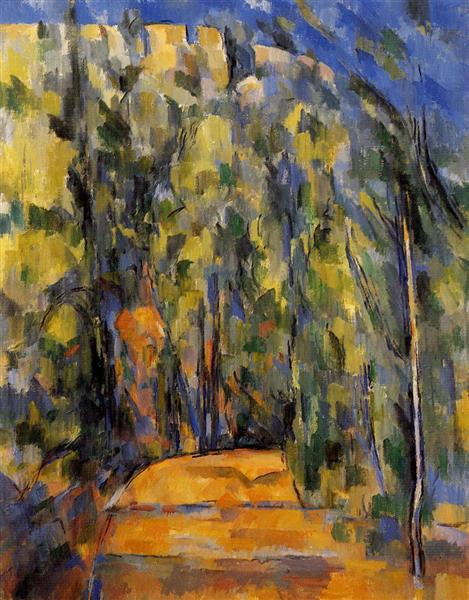Cézanne: Mistral of Aix-en-Province Part Two
Yuko Otomo
February 2018
 Portrait of Emile Zola (1864) & Self Portrait (1864)
Portrait of Emile Zola (1864) & Self Portrait (1864)
4. The Zola Dam
The friendship between Emile Zola & Cézanne is well known. As a matter of fact, we saw a French film “Cézanne et Moi” right before we left for the trip, coincidentally. It was a typical commercial bio-pic film, but nonetheless interesting enough since it was about them. Two passionate creative rebellious souls growing up together in the same town, going to the same school & sharing the joys & pain of life, of childhood, youth & adulthood to later break up their close friendship over “La Oeuvre: The Work” (1886) that Zola wrote. Its main character was based on Cézanne committing suicide in front of his painting at the end of the story. Cézanne hated it understandably. Contrarily, he loved Balzac’s “The Unknown Masterpiece” (1831) & said “c’est moi, Frenhofer”, talking of its main protagonist. How he reacted to the two different depictions of “an artist” so differently is fascinating. Cézanne & Zola inspired each other as they grew up. I wonder what would have happened to their creative personalities if they didn’t grow up knowing & influencing each other.
I almost forgot about Zola totally since I was overexcited visiting his studio and until I finally saw Mt. Saint Victoire. There was a dam, blocking a “pure as possible” face to face encounter with his mountain. The Zola Dam. It is a modern dam. It is still active with a big crane set for more construction at some point, or repair or something. I saw people walking on the passageway to get to the other side of the landscape where Emmanuelle said Cézanne had another atelier that he used to paint the mountain closer & from a different angle. We had no time to go there, so, I just let my imagination run. Next time. I’d be in his shack. Next time.
Ironically, as the name indicates, the dam was built by Zola’s father. He worked against protests & finished it in 1854. Cézanne even painted it in a few oil works such as “The Zola Dam” (1877-78) & did some charcoal drawings of it. But, no matter what, visually it was a vulgar reminder of our human reality. It prevented me from having a close “pure as possible” encounter with this sacred mountain. It was as if some wrong note was played in the flow of impeccable music. I tried my best to ignore the bothersome visual impact of the huge dam sitting nonchalantly between the mountain & myself. In order to go to Cézanne’s mountain atelier, you needed to walk on the Zola Dam. Even after they were both gone, the relationship between Cézanne & Zola is closely knit in a very complex way.
 Clearing (1867)
Clearing (1867)
5. Picasso’s Resting Place
After totally immersing ourselves in the majestic view of Mt. Saint Victoire, Emmanuelle suggested that we’d go see Picasso’s resting place north of the mountain outside Aix. She said she knew a café restaurant where we could sit, rest & see his “chateau” where he laid eternally with his 2nd wife Jacqueline. She drove us to the other side of the mountain to a small village Vauvennargue, where Picasso loved & lived briefly from 1959 to 1962. After his death, Jacqueline buried him in the front yard of the castle. Then, later, Jacqueline who killed herself was buried next to him by her daughter from her first marriage who still lives there. We were told that Picasso was the last “French” man to get buried on his own land. Since then, the law has changed & no one is allowed to be buried in one’s privately own garden or land any more. We are told that they are resting next to each other in a large circle shaped garden in front of the building with Picasso’s sculpture standing in the middle.
The small village Picasso loved was going through heavy reconstruction & canalization & most parts of the village were a mess. We stood on the cliff looking at the huge medieval chateau Picasso purchased in 1958, more than a half century after Cézanne’s death. It was located in the backside/shadow of Mt. Sainte Victoire. Picasso was so proud that he purchased a castle near his master’s mountain. Famously & vulgarly he said, “J’ai achet la Saint-Victoire (I bought Saint-Victoire)”, meaning “I bought Cézanne’s mountain.” It is said that he even had said, “Cézanne painted this mountain & now I own it.” What an amazing difference between Cézanne’s humble 2 story wooden house & this huge medieval castle made of stones! It was as if the difference was showing the true colors of Cézanne’s spirit & Picasso’s ego. Yes, Picasso wanted to be close to the spiritual sacredness of his master’s sacred mountain. But, he could only be in the northern shadow of the mountain. Doing so, he thought he was able to be close to the master he admired secretly & openly. Remember Picasso & Matisse both claimed, “Cézanne is the father to us all.”
It was a strangely pensive experience to see his chateau after being baptized by the majesty & beauty of the sacred mountain. It was as if we got pulled down by a vulgar human comedy. Picasso & his women & his castle. A communist who became a dominating king. Cézanne, a son of a banker who lived as a hermit monk. A castle & a wooden house. Cézanne who opened the door to abstraction because of his dedicated involvement to time/space. Picasso who was afraid of abstraction at the end of his creative life because of his fear of time/space. Cézanne who was a classicist. Picasso who was an avant-garde. Cézanne who saw the truth of cosmic truth. Picasso who went back to classicism at the end. Cézanne who saw 色即是空空即是色(color is void; void is color). Picasso who saw ‘void’ in his self-portrait. Ahhh… art is honest & cruel as it should be.
Later in the evening, when we had a salon reading concert @ the top floor apartment of Vincent Laju, an Aix musician. Aida told me that she was in Picasso’s castle once with her mother when it was open to the public in 2009. The chateau has still been occupied by Picasso’s family, Jacqueline’s daughter* to be correct, as a private space even now, but it was briefly opened to the public while the Picasso Museum in the Marais district in Paris was closed for renovations. The French cultural ministry decided to open the castle as a trade-off for the closed, under-renovation Museum in the capital. Aida & her mother were part of a guided tour of the castle on this rare occasion. She told us that the guide said that the last thing Picasso did in this castle was to paint the bathroom himself. I asked her “In what color?” she answered “In green!”
Green colors of pines; a green color of the bathroom. Either way, a life of a painter is consumed by the act of painting. What a strange & majestic thing it is! I was rather moved to imagine a not so young and already super famous Picasso painting his bathroom himself in green, living surrounded by a green valley behind the sacred mountain of his master that he thought he bought. Ahh… all is vain… all is well…
As I finish this segment, Jacqueline’s daughter, Catherine Hutin-Blay, just announced that she’d open a new Picasso Museum under her mother & her step father’s names in the 13th century convent in Aix-en-Provence in 2021. It’ll hold her inherited 2000 Picasso works, 1000 paintings & 1000 other works, including 400 portrait of her mother Jacqueline created between 1952-1973. Some of the works must have been painted in this castle. How strange it is that Picasso is still following his master without him knowing it, to make the master’s town as his!
You can see some of Cézanne’s work in the permanent collection of the Granet Museum that was built after another local artist, loved & well respected, Francois Mauris Granet (1775-1849) in Aix. But, where is the Cézanne Museum? His humble atelier? or in the under-renovation-construction Jas De Bouffan?
 Bend in Forest Road (1906)
Bend in Forest Road (1906)
6. The Dreyfus Affairs
Now, Aix-en-Provence is a college town & has a modern day liberal energy & spirit. In Cézanne’s era, it was one of the most conservative regions in France where Catholicism, the pre-revolution history of the country & where the local politicality prevailed. The Dreyfus Affairs (1894-1906) that split France into two affected the local acceptance of Zola & Cézanne severely. I wonder about a certain blunt “un-care-ness” hanging around the reception of Cézanne as a local hero even in our time has something to do with the lingering conservatism relating to the Dreyfus Affairs in Aix. Cézanne had to deal with the abusive treatment because he was a friend of Zola. Zola did not live in provincial Aix. Cézanne did.
Cézanne’s creative association with the politically controversial Courbet who was the main force of the Paris Commune (1871) could have played another factor of the ill treatments he had to bare from the bourgeois society of Aix. They were not happy about Cézanne’s association with this painter either. Although he was not out spoken politically, Cézanne was too much of a rebel to live in the conservative provincialism. Not just political issues, but, he also had to deal with a provincial conservative taste on art in the region. The abusive treatments he got from the locals are heartbreaking & unbelievable. Even now, compared to the passionate acceptance of Monet & the Spaniard Picasso by the French, Cézanne is still treated with a general indifference. For what he has done for the history of art, he should be well respected as a National Treasure. But maybe, he would rather be left alone quietly ignored as it is, I don’t know. The ambivalent & unsettling feeling kept surfacing in me all through the day, as I got ecstatic being in his “country.” I just could not imagine that grown-ups of the community did not stop local kids from throwing rocks & mud at the artist, calling him “a mad man”. At the height of the Dreyfuss Affairs, maybe it might have been a normal thing to show this type of cruelty & violence. Cezanne died in 1906 when this political scandal finally & almost settled down.
Link to Cézanne: Mistral of Aix-en-Provence, Part One
